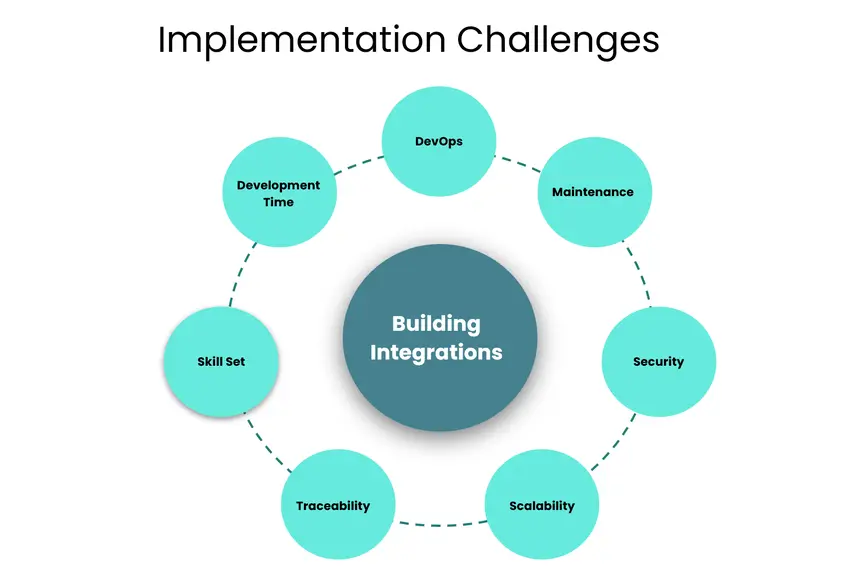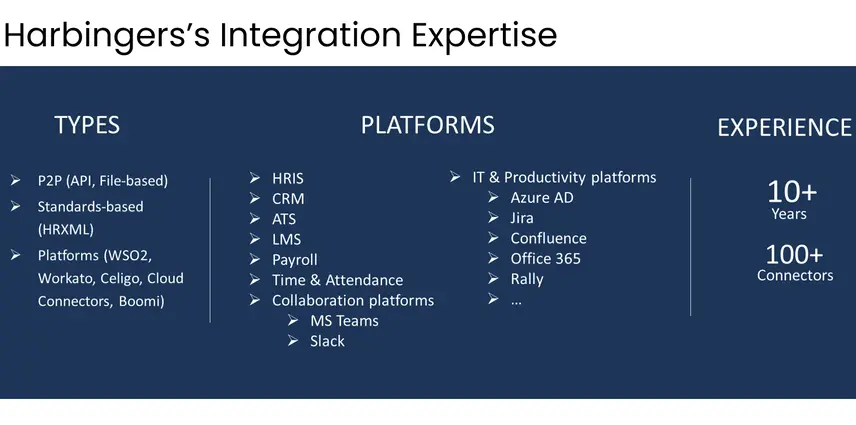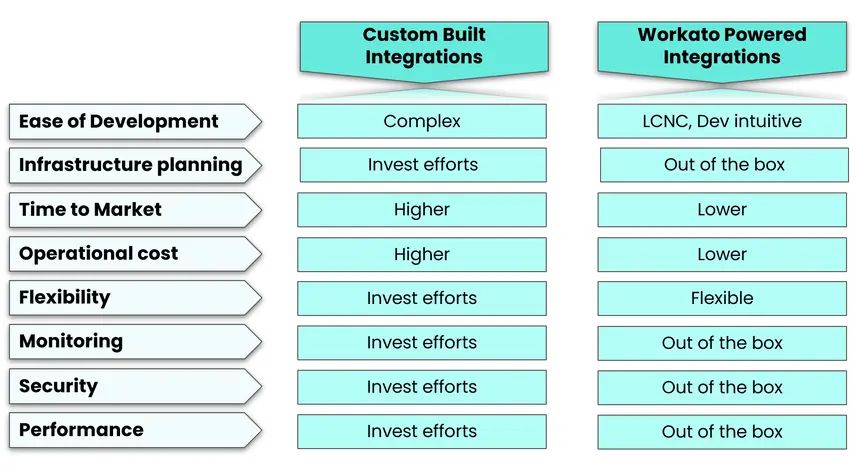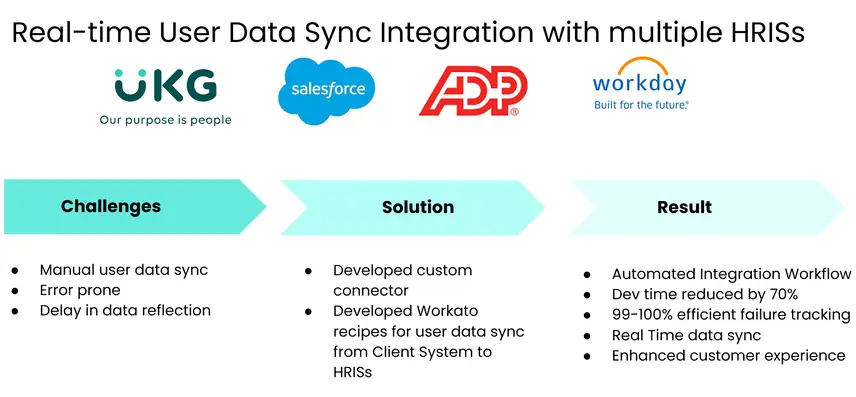
In order to drive business efficiencies, HR teams are pushing to streamline their workflows, automate complex administrative tasks, and operate with greater efficiency. As a result of this shift, scalable HR integration and automation has become a critical business need.
Many organizations are leveraging HR automation and integration platforms to mitigate functional intricacies, save time and effort, and ensure seamless interoperability. They are adopting modern technologies to overcome complex HR challenges.
But the question is how do you accelerate the delivery of and scale HR integration and automation? Recently, Harbinger and Workato co-presented an exciting webinar on ‘How to Accelerate the Delivery of Scalable HR Integration and Automation’ to answer this question.
The virtual roundtable discussion was hosted by Janhavi Padture, Vice President, Strategy & Business Development, Harbinger Group and featured industry experts Rashmi Kulkarni, Tech Architect & Delivery Expert, Harbinger Group and Vasanth Chakravarthi, Solutions Architect, Presales Expert, Workato.
Here are the key takeaways from the webinar:
- HR integration and automation from the delivery and business perspectives
- How to save time, cost, and effort and facilitate the work of developers and architects
- How to improve maintainability and scalability
- RecipeOps, API platform, and on-prem connectivity
- Custom vs. Workato-powered integrations
- Development and delivery use cases and success stories
If you want to dive deep into all these points, feel free to watch the on-demand webinar.
Why You Need HR Integration
Businesses use several HR platforms serving all kinds of requirements. These functions and features are scattered; thus, it becomes imperative to make the HR systems talk to each other for a seamless and integrated view. The involvement of multiple HR systems calls for data uniformity from where one can have a coherent source of information.
There are many opportunities where HR workflow automation shines and makes the work of HR effortless and effective. With the help of integration, HR workflows can be made efficient as well. For example, integrating ATS with HRIS and payroll can enhance candidate and employee experience and accelerate the HR processes.
Implementing Custom HR Integration: Challenges
“Integration enables the system to work together efficiently, but building an effective integration has its challenges.”
- Rashmi Kulkarni, Tech Architect & Delivery Expert, Harbinger Group
“Integration is no longer an IT or technical domain. Platforms must support a range of users, from business technologists, experts, product leaders to integration specialists or engineers.”
- Vasanth Chakravarthi, Solution Architect, Presales Expert, Workato
- Rashmi Kulkarni, Tech Architect & Delivery Expert, Harbinger Group
- Vasanth Chakravarthi, Solution Architect, Presales Expert, Workato
Integrating different systems for a coherent view can be a challenging task. For instance, the involved systems have their own technology stack, authentication strategy, API layer, ways of managing connections and information, and many other aspects. For managing a variety of tech stacks and approaches, we need to account for specific skillsets familiar with the included technology.

Building an integration demands as much effort as developing a project from scratch:
- Designing
- Evaluating the tech stack
- Working on the architecture of the components
- Managing infrastructure deployment
Post-deployment demands security – a critical aspect of integration – once the deployment is done. Managing designated access for the deployed environment or integrated system is a concern when security is on the table.
How do you overcome such challenges with an outcome of successful scalable HR integration or scalable HR automation? Here, iPaaS can be the best and most robust solution.
Easy Employee Data Sync with HR Workflow Integration and Automation for a Blockchain Data Platform
Harbinger helped a US-based blockchain data platform resolve employee management issues, record integration issues between their existing platform and ADP Workforce Now, and with real-time sync of new/updated employees.
Integration and Automation for Everyone
Workato is a next-generation iPaas platform with data integration and process automation through a low-code no-code approach. They have democratized integration where a person with a good skill set, and proper technical guidance can build integrations and recipes effortlessly.
By harnessing the power of such a powerful iPaas, you can build any workflow from a simple to an advanced complexity level. Moreover, the recipes can connect with thousands of applications, whether they are cloud-based or on-premises.
“Integration enables the system to work together efficiently, but building an effective integration has its challenges.”
- Rashmi Kulkarni, Tech Architect & Delivery Expert, Harbinger Group
“Integration is no longer an IT or technical domain. Platforms must support a range of users, from business technologists, experts, product leaders to integration specialists or engineers.”
- Vasanth Chakravarthi, Solution Architect, Presales Expert, Workato
- Rashmi Kulkarni, Tech Architect & Delivery Expert, Harbinger Group
- Vasanth Chakravarthi, Solution Architect, Presales Expert, Workato
To unleash the unlimited potential of the automation and integration offerings, Harbinger – Workato Certified Partner is here. Let’s dive deeper into how we could help to achieve your business goals.
Harbinger + Workato for Scalable HR Integration and Automation
Harbinger decided to strategically partner with one of the leading iPaaS platforms, i.e., Workato, for scalable HR integration delivery.
Our dedicated teams have extensive experience in scalable HR integration and HR integration delivery. We understand Workato best practices, RecipeOps, lifecycle management, and other essential aspects to ensure the best delivery of Workato integration and automation.
When we say we have over a decade of experience in scalable HR integration and HR integration delivery, here is what we mean

Custom vs. Workato-Powered Integration
Harbinger HRTech experts have experience of both the worlds: custom integrations and Workato-powered integrations. Let’s know the differences between both the approaches.
Custom-Built Integration
Custom integration is generally more complicated. It demands as much effort and time as we need when developing a project from scratch. One needs to look into all different aspects – designing the architecture, code components, connections, and so on. It needs infrastructure planning and designing.
Due to this, the time-to-market and operational cost are higher when building a custom integration. In addition to that, the scope of flexibility, monitoring, and security is comparatively lower than Workato integrations.
We can conclude that custom integration can be helpful for 1-2 integration use cases. However, if we are looking at over 1-2 integration use cases, then custom integration would be a complicated option to employ.
Workato-Powered Integration
Harbinger HRTech experts observed that all the excessive efforts and time needed for developing integrations can be eliminated with Workato-powered integrations. Developers can jump into the core integration by leveraging low-code/no-code behavior. A library of more than a thousand connectors and numerous recipe templates can help developers accelerate the overall development process.
As a result, the time-to-market and operational cost with Workato integration are comparatively lower than custom connectors. Moreover, Workato offers immense flexibility and scalability. Workato is very comprehensive when it comes to security, and we don’t need to worry about crucial areas concerning security.

A Success Story
Here is an exciting success story Harbinger created for one of its clients. This success story focused on Real-Time User Data Sync Integration with Multiple HRIS’s.
Our client wanted to integrate their custom-built ATS platform, which they use for mass recruiting, with multiple HRIS’s like UKG, Salesforce, ADP, and Workday. Our team had to deal with various challenges, such as manual user data sync, error-prone process, and delay in data reflection.
Harbinger used the Workato-based integration approach and developed a custom connector for their ATS platforms. Moreover, we built custom recipes for syncing user data from our client’s ATS platform to all the HRIS’s.

We achieved the following result for our client:
- Automated integration workflow
- 70% reduction in development time
- 99-100% efficient tracking of event failures
- Real-time data sync
- Enhanced customer experience
End Note
It is imperative to streamline and expedite the delivery of scalable HR integration and scalable HR automation. Our dedicated HRTech experts have immense experience when it comes to HR integration and automation. Are you looking for a helping hand to implement HR integration and automation for your business? We are just an email away! Contact our HRTech leaders now: contact@harbingergroup.com.






